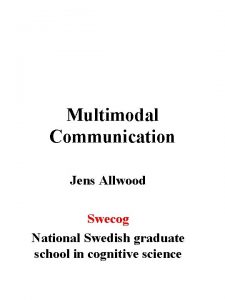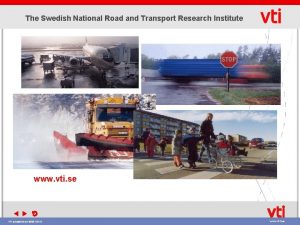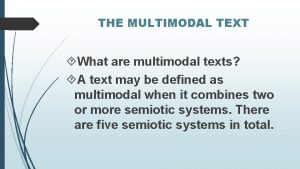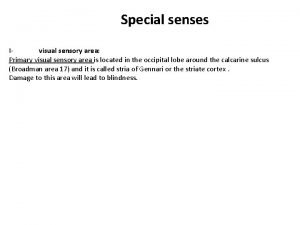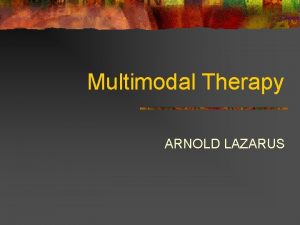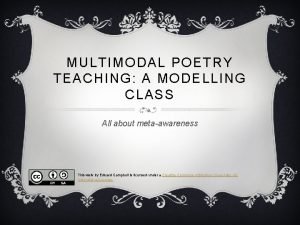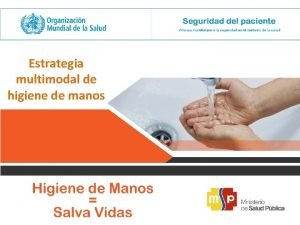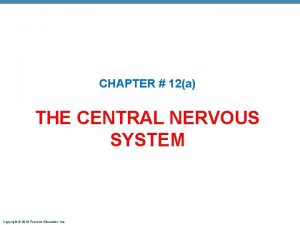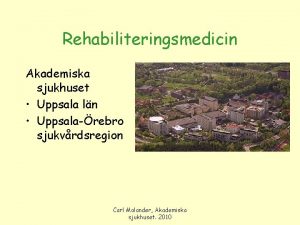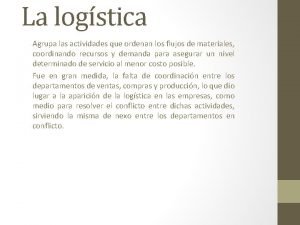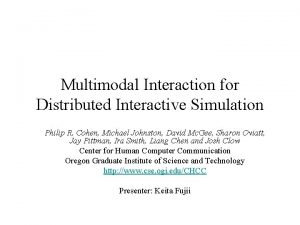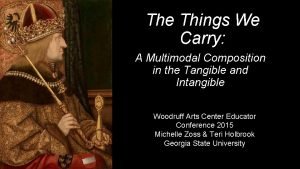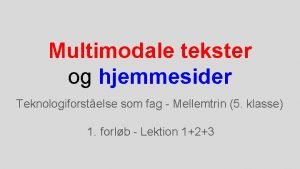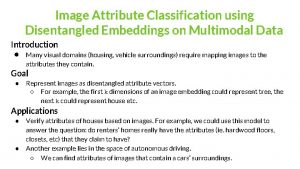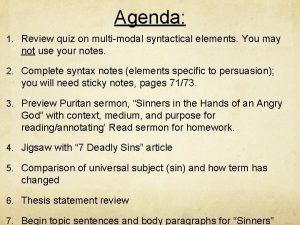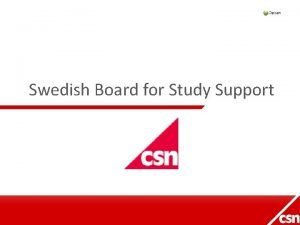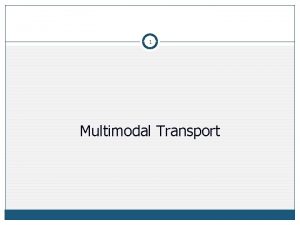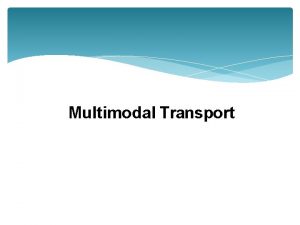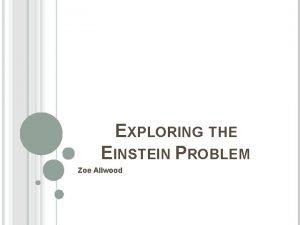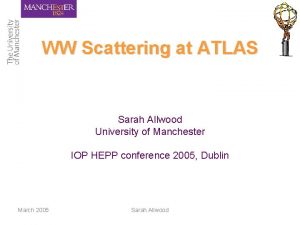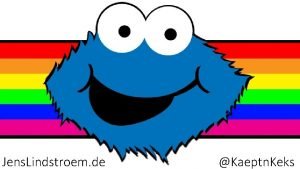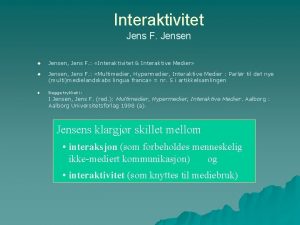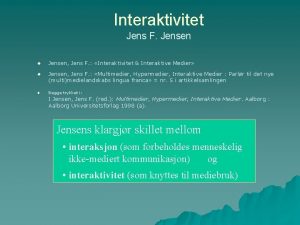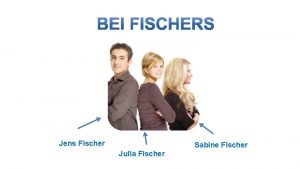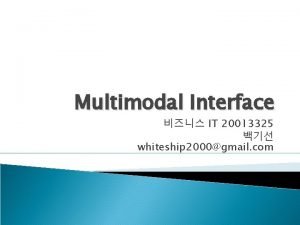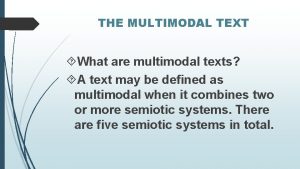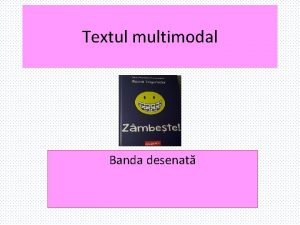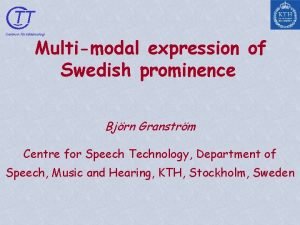Multimodal Communication Jens Allwood Swecog National Swedish graduate






















- Slides: 22

Multimodal Communication Jens Allwood Swecog National Swedish graduate school in cognitive science

Multimodal Communication 1. 2. 3. 4. 5. 6. Why study multimodal communication? What is multimodal communication? Multimodality in Human-Human Communication – Production – Types of Representation – Perception, Understanding – Contextual Dependence Some Theoretical issues How study multimodal communication? Multimodality and ICT (Information & Communication Technology)

Why study multimodal communication? • Interesting in itself. • What we are built for and are used to. - very much is still unknown - need for multimodal communication corpora - provides a background for what can be simulated or made use of in technical systems • Source for design of computer supported applications - gives redundance, robustness, synergy - more natural and efficient HMI - more efficient and enjoyable Human Communication

Examples - New interactive search machines (internet & local DB) - VR applications (games, education, trade) - Other educational support (Tutoring etc. ) - Public information - Commercial systems • Multimodality needs to be combined with multiculturality and multifunctionality

What is multimodal communication? Communication = def. Coactivation, sharing and coconstruction of information Mode/modality = manner, way Multimodal = Several alternatives of interpretation Main alternative 1. Modalities of perception and production Visual - gestures Auditory - sounds, speech Tactile - touch Olfactory - smell (molecules) Gustatory - taste (molecules) ? Submodalities color, shape & movement

Other alternatives 2. Medium = physical carrier Light waves, sound wave molecules, electromagnetic waves etc. 3. Type of representation = index, icon, symbol 4. Communication aids writing, radio, TV etc. Suggestion for definition: Multimodal Communication = coactivation, sharing and coconstruction of information simultaneously and sequentially through several modes of perception & production

Multimodal communication often becomes also • Multimedial ( always) • Multirepesentational • Using several aids of communiction

Types of representation 3 ways of carrying, conveying and sharing information • Index • Icon • Symbol All 3 are used simultaneously in ordinary human communication. E. g. Words (symbols) Gesture (icons) Voice quality (index) “I’m small” Variation in awareness and intentionality Bodily communication often more spontaneous, unaware, unintended (index, icon) than words (symbols).

Analysis of relation between Modalities necessary both for 1. production, planning of different simultaneous expressions and 2. perception, understanding of different simultaneous expressions

Theoretical Issues 1. How is (should) information (be) distributed (fission) in production across modalities, e g text, picture, voice, diagram, gesture 2. How is information from different modalities integrated (fusion) in reception? What function do the modalities have in relation to each other? 3. Which modes of production and perception are used in human-human communication (HHC)? 4. Are some forms of representation modality neutral and others modality specific? spoken (& written) language vs pictures

Theoretical issues continued 5. Is it possible to translate between modalities? – vision <-> hearing, – Smell < -> touch – touch <-> vision Broad conception of translation and context to determine meaning 6. Is it possible to translate between types of representation? Speech (symbol) <-> picture (icon) Speech (symbol) <-> freq diagram (index) 7. What is synesthesia? - activated complementary? 8. How can cognitive development in general/in different tasks best be supported by multimodal resources?

Theoretical issues continued 9. How do we formally represent symbolic non-vocal and non-verbal types of representation? 10. Problem Tradition of neglect of multimodal issues 11. How can the modes of production and perception be made use of, emulated, simulated in HMI (humanmachine interaction) and computer supported HHC?

How should multimodal communication be studied? 1. Descriptive and explanatory (audio, video recorded) studies of human-human communication in naturalistic settings – establishment of multimodal corpora and techniques for establishing and analyzing these 2. Experimental studies of human-human communication 3. Simulation of human-human communication (VR and robot) 4. Creation of multimodal application using Wizard of Oz techniques or “Dialog distilling”

Production Means of expression 1. Primary Directly controllable Body movements, voice, speech, song, touch, smell? , taste? Can involve symbols, icons & indeces Can be regulated by social convention 2. Secondary Aids for supporting, augmenting and preserving primary means of expression Writing, telephone, radio, TV 3. Tertiary Aids for supporting augmenting and preserving secondary means of expression Telegraph, fax, e-mail 4. Quarternary All human artifacts (collective communication) also unintended, undesired remains

Primary means Multimodal Face-to-face Communciation Production & perception

Communicative Body Movements 1)Facial gestures (nose, eyebrows, cheek, forehead, chin etc) 2)Head movements 3)Gaze direction, mutual gaze 4)Pupil size 5)Lip movements 6)Hand arm movements 7)Leg and foot movements 8)Body posture 9)Distance btw communicators 10) Spatial orientation 11) Clothing and bracelets 12) Touch 13) Smell 14) Taste 15) Non-linguistic sounds

Multimodal Face-to-face Communication

Three levels of intentionality in communication Indicate Display Signal All three occur simultaneously in normal human communication index indicate x display signal icon symbol x x All combinations are, in principle, possible, but the three x: s are more common.

One can increase awareness and intentionality through practice. indicate -> display -> signal What has been practiced can become a habit conventional signal -> automatic

Ways of processing information (reception) 1. Unaware reaction 2. Perception (apprehension) 3. Understanding 4. Other attitudes 5. Behavioral response 6. Other actions

Communication Coactivation, sharing and coconstruction between two or more agents Sender Recipient Representation Indicate Influence Index Display Perceive Icon Signal Understand Symbol Other attitudes Behavioral responses

Concluding remarks • Overview of multmodality in human communication
 Swecog
Swecog Swedish national road and transport research institute
Swedish national road and transport research institute Swedish national audit office
Swedish national audit office Usf bull sync
Usf bull sync Multimodal vs multimedia
Multimodal vs multimedia The multimodal text big ed mona
The multimodal text big ed mona Multimodal association areas
Multimodal association areas Lazarus multimodal therapy
Lazarus multimodal therapy Multimodal poem
Multimodal poem Componentes de la estrategia multimodal
Componentes de la estrategia multimodal Somatosensory association cortex
Somatosensory association cortex Multimodal rehabilitering
Multimodal rehabilitering Textos multimodal
Textos multimodal Desventajas del transporte intermodal
Desventajas del transporte intermodal Multimodal integration
Multimodal integration Multimodal composition
Multimodal composition Multimodale tekster
Multimodale tekster Multimodal attribute extraction
Multimodal attribute extraction Heteromodal definition
Heteromodal definition Multimodal elements quiz
Multimodal elements quiz Swedish ob gyn first hill
Swedish ob gyn first hill Swedish life sciences
Swedish life sciences Swedish csn
Swedish csn
